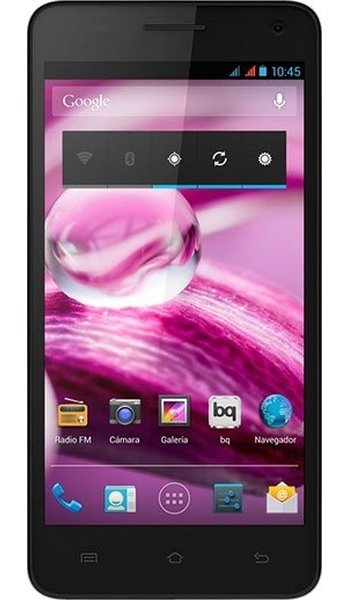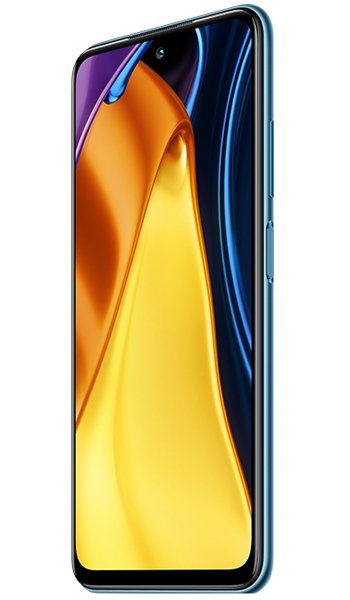BQ Aquaris 5.7 vs Xiaomi Poco M3 Pro 5G Comparison and Differences
Smartphone 1

BQ Aquaris 5.7
Smartphone 2

Xiaomi Poco M3 Pro 5G
Smartphone 3
BQ Aquaris 5.7 or Xiaomi Poco M3 Pro 5G Specs Comparison
or
 Common specs
Common specs
| Brand and model | BQ Aquaris 5.7 | Xiaomi Poco M3 Pro 5G | |
| Rating | (+0) | (+0) | |
| Release date | December, 2013 | 2021, May 19 | |
| Dimensions (HxWxD) | 165.0 x 81.6 x 10.0 mm | 6.5 x 6.5 x 3.21 in | 161.8 x 75.3 x 8.9 mm | 6.37 x 6.37 x 2.96 in | |
| Weight | 191 g | 6.74 oz | 190 g | 6.7 oz | |
| Body Build | Glass front (Gorilla Glass 3), plastic frame, plastic back | ||
| Case | buy from Amazon | buy from Amazon | |
| Colors | Black | Poco Yellow, Power Black, Cool Blue | |
| Battery | 4000 mAh, Li-Ion, | 5000 mAh, Li-Po, non-removable | |
| Approximate price | 180 EUR | ||
| Check price | from Amazon | from Amazon |
 Screen
Screen
| Technology | LCD IPS | IPS LCD | |
| Touchscreen | capacitive touchscreen | capacitive touchscreen | |
| Display colors | 16M | 16M | |
| Screen size | 5.7" in | 6.5" in | |
| Screen area | 102.0 cm2 | ||
| Screen format | 16:9 (height:width) | 20:9 (height:width) | |
| Screen to body ratio | 66% | 83.7% | |
| Screen resolution | 1080 x 1920 px | 1080 x 2400 px | |
| Screen PPI /points per inch/ | 386 PPI | 405 PPI | |
| Screen protection | Corning Gorilla Glass 3 | ||
| Other specs | - 90Hz -400 nits (typ) -500 nits |
||
| Screen protector | buy from Amazon | buy from Amazon |
 Camera and Video
Camera and Video
| Rear camera, main | 13 MP, Single | 48 MP, Triple | |
| Camera specs | -13 MP, Unknow, (wide) | -48 MP, f/1.8, 26mm (wide), 1/2.0'', 0.8µm, PDAF -2 MP, f/2.4, (macro) -2 MP, f/2.4, (depth) |
|
| Functions | LED flash | Dual-LED dual-tone flash, HDR, panorama | |
| Video | 1080p video | 1080p@30fps | |
| Front camera, selfie | 5 MP, Single | 8 MP, Single | |
| Specifications | 5 MP, ƒ/ | 8 MP, f/2.0, (wide) | |
| Functions | Panorama | ||
| Video | 1080p@30fps |
 Performance
Performance
| Operating system - OS | Android 4.1 Jelly Bean | Android 11, MIUI 12 | |
| Chipset | - MediaTek MT6589T (28 nm) | - MediaTek MT6833 Dimensity 700 5G (7 nm) | |
| CPU | - Quad-Core (4x Cortex A7 1.5 GHz) | - Octa-core (2x2.2 GHz Cortex-A76 & 6x2.0 GHz Cortex-A55) | |
| GPU | PowerVR SGX544 | Mali-G57 MC2 | |
| External memory | microSDXC (uses shared SIM slot) | ||
| Internal memory | 2GB 16GB, 2GB · 16GB | 64GB 4GB RAM, 128GB 6GB RAM |
 Benchmark
Benchmark
| Antutu 9 Total | 324323 | ||
| GeekBench 5 Single Core | 520 | ||
| GeekBench 5 Multi-Core | 1660 |
 Communication and Connectivity
Communication and Connectivity
| SIM card | Dual SIM, dual stand-by (Unknown + Unknown) | Hybrid Dual SIM (Nano-SIM, dual stand-by) | |
| Network | 2G / 3G / | GSM / HSPA / LTE / 5G | |
| Bands | -2G - B2 (1900), B3 (1800), B5 (850), B8 (900) -3G - B1 (2100), B8 (900) |
-2G - GSM 850 / 900 / 1800 / 1900 - SIM 1 & SIM 2 -3G - HSDPA 850 / 900 / 1700(AWS) / 1900 / 2100 -4G - 1, 2, 3, 4, 5, 7, 8, 12, 17, 20, 28, 32, 38, 40, 41, 66 -5G - 1, 3, 7, 8, 20, 28, 38, 40, 41, 66, 77, 78 SA/NSA |
|
| Speed | HSPA 42.2/5.76 Mbps, LTE-A (CA), 5G | ||
| GPRS | Yes | Yes | |
| Edge | Yes | Yes | |
| Wi-Fi | 802.11b, 802.11g , 802.11n | Wi-Fi 802.11 a/b/g/n/ac, dual-band, Wi-Fi Direct, hotspot | |
| GPS | Yes | Yes, with A-GPS, GLONASS, GALILEO, BDS | |
| NFC | No | Yes (market/region dependent) | |
| USB | Yes | USB Type-C 2.0 | |
| Bluetooth | , | 5.1, A2DP, LE |
 Music and Audio
Music and Audio
| Radio | Yes | FM radio | |
| Headphone jack | Yes | Yes | |
| Others | - 24-bit/192kHz audio |
 Other features
Other features
| Sensors | - Proximity, compass, gyro | - Fingerprint (side-mounted), accelerometer, gyro, proximity, compass , Infrared port | |
| Other extras |
- Fast charging 18W |
Reviews and Opinions on BQ Aquaris 5.7 and Xiaomi Poco M3 Pro 5G
If you had to recommend one of these phones to a friend, which one would it be and why? Share your arguments using the Add Opinion button!
